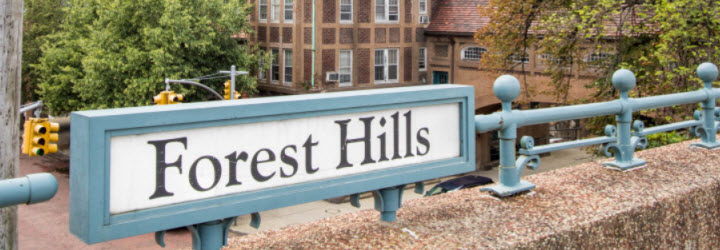Forest Hills is a mostly residential neighborhood in the central portion of the borough of Queens in New York City. The north, east, and south boundaries are the Long Island Expressway (LIE), Grand Central Parkway, and Union Turnpike, respectively. With its western boundary running roughly along 102nd Street, 67th Avenue, and the Long Island Rail Road’s former Rockaway Beach Branch; while the Encyclopedia of New York City defines the western boundary as Junction Boulevard and the former Rockaway Beach Branch of the Long Island Railroad. Forest Hills is located in Queens Community District 6 and its ZIP Code is 11375.
The commercial district of Forest Hills is a mile-long stretch of Austin Street between Yellowstone Boulevard and Ascan Avenue. Austin Street contains a mix of bars, restaurants, cafes, boutiques and chain stores. Forest Hills is bordered by Flushing Meadows–Corona Park and Forest Park, two of the largest parks in Queens. It’s Long Island Railroad station was built with a brick courtyard, a clock tower, and arch-filled underpasses, in fitting with the surrounding, historical Forest Hills Gardens section of the neighborhood.
In 1895, famed landscape designers Olmstead, Olmstead & Eliot, were commissioned to design Forest Park on the southern end of Forest Hills. The adjacent neighborhood was planned on the model of the garden communities of England, with its own inn, garage, and post office resulting with the turn of the century development of numerous Tudor-style homes in Forest Hills. The more sprawling ones are located in exclusive Forest Hills Gardens, but most are located in the section loosely bounded by 68th Avenue on the north; 72nd Road on the south; 108th Street on the west; and Grand Central Parkway on the east.
The southern part of Forest Hills contains a particularly diverse mixture of upscale housing, ranging from single-family houses, attached townhouses, and both low-rise and high-rise apartment buildings. South of the Long Island Rail Road, and the Forest Hills Gardens area is a private community that features some of the most expensive residential properties in Queens County. The north side of Forest Hills is home to the Cord Meyer community, which contains detached single-family homes. Teardowns and their replacement with larger single family residences commonly referred to derisively as “McMansions” has had a significant impact on the architectural integrity of the area since the late 90’s.
The southeastern portion of Forest Hills contains Forest Hills South, a complex of 7 Georgian apartment buildings centered around a private English garden, which was formerly a mapped portion of 113th Street prior to the complex’s construction in 1939. Architect Philip Birnbaum designed this charming enclave.
Philip Birnbaum and Alfred Kaskel also designed and constructed numerous grand, pre-war apartment buildings scattered throughout the Forest Hills community. These buildings include the Grover Cleveland, the Van Buren Apartments, the Thomas Jefferson, the Maplewood, the Richard Apartments, the Stephen Apartments, the James Madison, the Cedar Apartments, the Howard Apartments, the James Monroe, the Nathan Hale, the St. Regis, the Roanoke, and the Kennedy House. Birnbaum and Kaskel’s buildings remain standing today, and are distinguished by their spacious lobbies, interior courtyards with fountains, curved brick corner terraces, and sunlit exposures. Other notable contemporary designed high-rise apartment buildings include the Continental (on 108th Street), the Pinnacle, Parker Towers, the Windsor and a 17-story luxury condo building completed in 2014, the Aston.
Forest Hills has a historical association with tennis: the Forest Hills Stadium hosted the U.S. Open until 1978 before to moving to the U.S.T.A. Billie Jean King National Tennis Center in Fresh Meadows-Corona Park, making Forest Hills synonymous with tennis for generations. And the current West Side Tennis Club still offers grass courts for its members. The famed, former Forest Hills Stadium has also hosted numerous music concerts including most notably, The Beatles in 1964. After the U.S. Open departed for Flushing Meadows, it resumed hosting music concerts during the summer of 2013 when the British rock band Mumford & Sons played there to an overflowing crowd.


